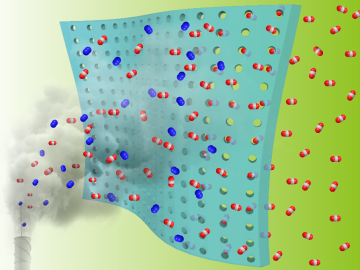
Filter News
Area of Research
- (-) Electricity and Smart Grid (1)
- (-) Materials (71)
- (-) National Security (17)
- Advanced Manufacturing (6)
- Biological Systems (2)
- Biology and Environment (125)
- Biology and Soft Matter (1)
- Computational Engineering (2)
- Computer Science (5)
- Energy Science (104)
- Fuel Cycle Science and Technology (1)
- Functional Materials for Energy (1)
- Fusion and Fission (30)
- Fusion Energy (10)
- Isotope Development and Production (1)
- Isotopes (4)
- Materials for Computing (7)
- Mathematics (1)
- Neutron Science (19)
- Nuclear Science and Technology (40)
- Nuclear Systems Modeling, Simulation and Validation (1)
- Quantum information Science (2)
- Supercomputing (57)
News Topics
- (-) Big Data (7)
- (-) Bioenergy (14)
- (-) Composites (9)
- (-) Environment (20)
- (-) Microscopy (27)
- (-) Molten Salt (3)
- (-) Nuclear Energy (21)
- 3-D Printing/Advanced Manufacturing (25)
- Advanced Reactors (5)
- Artificial Intelligence (21)
- Biology (8)
- Biomedical (8)
- Biotechnology (1)
- Buildings (6)
- Chemical Sciences (32)
- Clean Water (3)
- Computer Science (33)
- Coronavirus (6)
- Critical Materials (13)
- Cybersecurity (21)
- Energy Storage (35)
- Exascale Computing (2)
- Frontier (3)
- Fusion (8)
- Grid (13)
- High-Performance Computing (8)
- Irradiation (1)
- Isotopes (13)
- ITER (1)
- Machine Learning (16)
- Materials (74)
- Materials Science (78)
- Mathematics (1)
- Microelectronics (1)
- Nanotechnology (39)
- National Security (35)
- Neutron Science (35)
- Partnerships (15)
- Physics (28)
- Polymers (17)
- Quantum Computing (3)
- Quantum Science (12)
- Security (11)
- Simulation (2)
- Space Exploration (2)
- Summit (4)
- Transportation (16)
Media Contacts

Oak Ridge National Laboratory researchers have built a novel microscope that provides a “chemical lens” for viewing biological systems including cell membranes and biofilms.

Researchers at the Department of Energy’s Oak Ridge National Laboratory and the University of Tennessee, Knoxville, are advancing gas membrane materials to expand practical technology options for reducing industrial carbon emissions.

In the search to create materials that can withstand extreme radiation, Yanwen Zhang, a researcher at the Department of Energy’s Oak Ridge National Laboratory, says that materials scientists must think outside the box.

Scientists at the Department of Energy Manufacturing Demonstration Facility at ORNL have their eyes on the prize: the Transformational Challenge Reactor, or TCR, a microreactor built using 3D printing and other new approaches that will be up and running by 2023.

In the race to identify solutions to the COVID-19 pandemic, researchers at the Department of Energy’s Oak Ridge National Laboratory are joining the fight by applying expertise in computational science, advanced manufacturing, data science and neutron science.

Scientists at Oak Ridge National Laboratory used a focused beam of electrons to stitch platinum-silicon molecules into graphene, marking the first deliberate insertion of artificial molecules into a graphene host matrix.

A novel approach developed by scientists at ORNL can scan massive datasets of large-scale satellite images to more accurately map infrastructure – such as buildings and roads – in hours versus days.

Liam Collins was drawn to study physics to understand “hidden things” and honed his expertise in microscopy so that he could bring them to light.

Students often participate in internships and receive formal training in their chosen career fields during college, but some pursue professional development opportunities even earlier.

Researchers at the Department of Energy’s Oak Ridge National Laboratory have received five 2019 R&D 100 Awards, increasing the lab’s total to 221 since the award’s inception in 1963.


